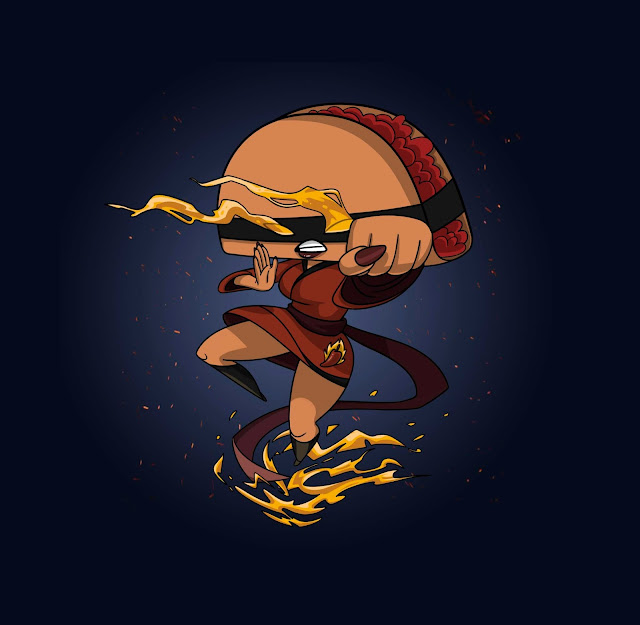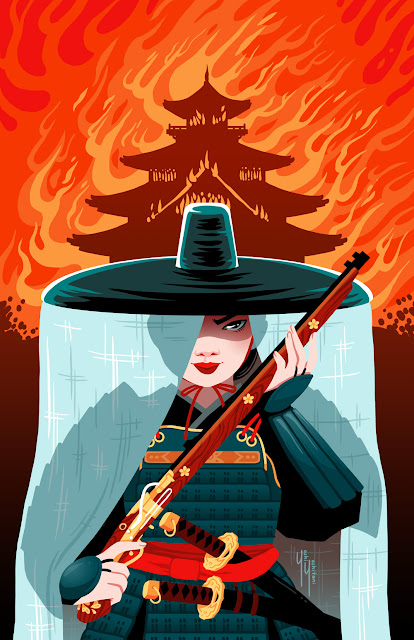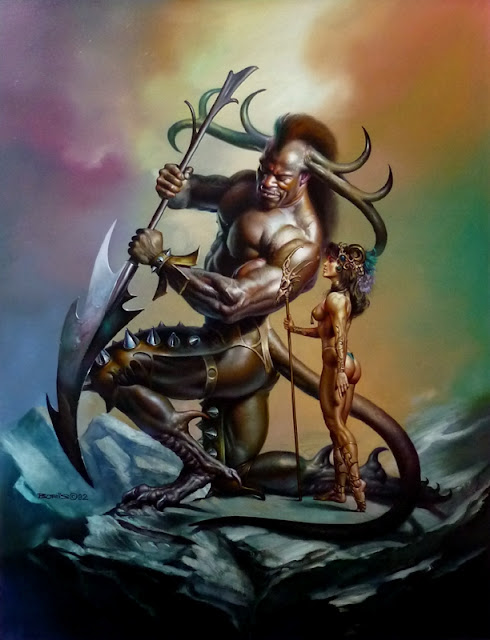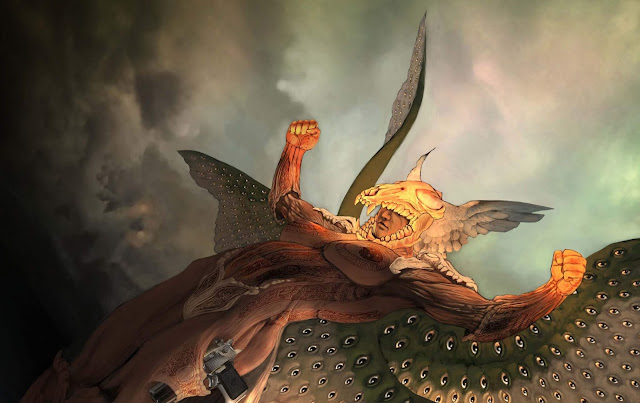I just wanted to do a brief post about Turn and identity, on this, our
turning point to the second half of the Kickstarter. You can check out Turn's Kickstarter at
https://www.kickstarter.com/projects/briecs/turn-a-tabletop-roleplaying-game. Content warning for discussion of mental health, depression, and mentions of binge drinking/alcoholism and suicidal ideation.
I want to talk about what it means to be two (or more) things in one person. I come at this from a couple of different axes, and some people have more. Mine are really tied to people's perception for some of these, but others are truly just inherently who I am.
Let me try to separate them a little.
As far as perception, to many people, I'm a cis woman. In reality, I'm not. So I live with perceived-me as cis woman, and actual-me as not. As well, I'm not perceived as disabled, but in reality, I am. So I live as perceived-me and able, and actual-me as disabled. I also appear straight - I'm even in a perceived-straight relationship. But I'm not! I'm queer as hell. So, perceived-me and actual-me again at odds.
It goes deeper, I say, in a Morpheus voice.
I am actually both nonbinary and masculine. Simultaneously, most of the time, though in different amounts. This is big, and important. One of the biggest ones, though, is that I have bipolar disorder. Even when I am at the height of mania, my depression looms and can tug at me in moments when I'm sensitive, and vice versa. My mania (including hypomania) and depression, they're a part of me, even when I'm incredibly well-medicated.
Around 2012, I entered into a mixed episode. (A slow slide.) This is when you're kind of manic and depressed all at once! It is, shall we say, a bad time. It lasted years. Many of my readers knew me during this time period, through what I call The Dark Years, because I lost a lot of memories due to blackouts both from mania and from alcohol abuse. Not great.
However, I started working on Turn in 2013. This isn't a coincidence. I don't talk about this part of Turn very much because it's still incredibly hard for me. I've been asked in a few interviews, and only went into it in detail relating to this specific subject on one, about why shapeshifters are great to tell stories about. There are tons of reasons - they're fun, they can be used as a metaphor, they're powerful and interesting. But shapeshifters - multiple identities in one body? I understand that, I live that.

From 2012 until a ways into 2015, I was what some people consider "crazy." I was fighting with my mental illness, making tons of bad choices, but also continuing to grow my business, attending university, and so on. I was struggling between the intense, high, selfish, egotistical mania and the soul-sucking, exhausting, lonely, self-loathing depression. During all of this, I got to see that neither side - in me personally - existed without the other, that they fed into each other, interacted with each other, and that there were things I could do where both would work together, or where I could find a harmony. That eventual harmony did actually lead me to getting help, going on lithium, quitting binge drinking, and ending harmful relationships.
And there, you can see a burning light of hope.
I have always identified with shapeshifters, having a hidden identity of some kind with everyone most of my life. They are part of Turn, and are good to make stories about, because of what I said - they're interesting, fun, powerful, and great metaphors for people to place upon themselves. But I would be lying if I didn't say that the actual design of Turn wasn't heavily influenced by my own conflicting identity.
I've had reason to think about it a lot over the Kickstarter, and while I personally struggle to find mental health support on Medicaid. The fear of falling back into those dark days is real, let me tell you. But, in thinking, I wanted to share that the design of shapeshifters in Turn, to have these different parts of their identity that they struggle between, that they must find balance within? That's bred out of true hope.

Many people have different sides to them, and it's hard to deal with it sometimes. When I think of when I was first conceiving the Struggles in Turn, the mechanics for how you resolve conflicts between your beast and human identities and their wants and needs when you take action, I thought of how every day when I was struggling with my mental health, I had to choose my consequences. Sometimes it meant I'd sacrifice face, sometimes I'd deal with physical fallout, and sometimes I'd have other worse consequences for whatever ridiculous shit I got up to that day. I couldn't always predict them and sometimes I'd just end up with the whole mess (hello, 6-).
And it was also always about the drawbacks that my one part of me had pulling against the other. When I was more manic and just trying to slam down a conversation at a convention, my depressive side would push for me to say things that were self-deprecating. When I was a miserable mess and struggling from the edge of suicide, the mania would suggest self-destructive methods. It was kind of rough, honestly.
When I put these into Turn, though, I didn't want all that bad shit coming with it. For me, I wanted shapeshifters to be something beautiful! I was okay with them having hard stuff they dealt with, but it wasn't about either side of them being dark, or self-destructive, or harmful. They're just both parts of the being with needs and wants that the shifters have to struggle to satisfy or meet, even if it's hard, and the biggest aspect is that they're just trying to show up the way everyone wants them to show up. That's why exposure is a mechanic, because the real hard part of all of this is the world, not their identity. Shifters are good!
I want to talk more about shapeshifters being beautiful and good so I will soon, but this is getting a little long.
Basically, shapeshifters are whatever you want them to be in what they stand for or are a metaphor for. You can play them in a bunch of different ways! But the reason why their mechanics work the way they do is because I discovered through struggles with my bipolar disorder that these complex multi-faceted identities aren't actually binary structures! Even my mania has some sadness, even my depression has some egotism. It's not exactly a fun way to figure out how to design a game, but it's a real one.
So the shapeshifters in Turn are complex. They are not all beast when they're a beast, and they're not all human when they're a human. They're a little bit of each, regardless of their form, in different amounts. And I thought about this intensely during throes of mania and depths of depression! So I can tell you with all honesty that there are no perfect metaphors. But I'll tell you this: shapeshifters don't have a special tweenie form like many shapeshifter versions do because I will never have a happy medium, and I had to find a way into the light without one. I think the story is stronger that way, and it's a story I know how to tell.
If you liked reading about Turn and want to support it,
the Kickstarter runs until November 30,
so please consider backing it. If this resonated with you, please feel free to share your experiences with having a multi-faceted identity - you can even use the #turnrpg and #myturnID hashtags if you'd like. I know I'm not alone in being a person with many sides, and I appreciate the power of sharing our stories.
Until next time:
P.S. - If you're a Patreon backer, let me know if you think I should charge for this post!
Thoughty is supported by the community on
patreon.com/thoughty. Tell your friends!
To leave some cash in the tip jar, go to
http://paypal.me/thoughty.
If you'd like to be interviewed for Thoughty, or have a project featured, follow the instructions on the
Contact page.
































